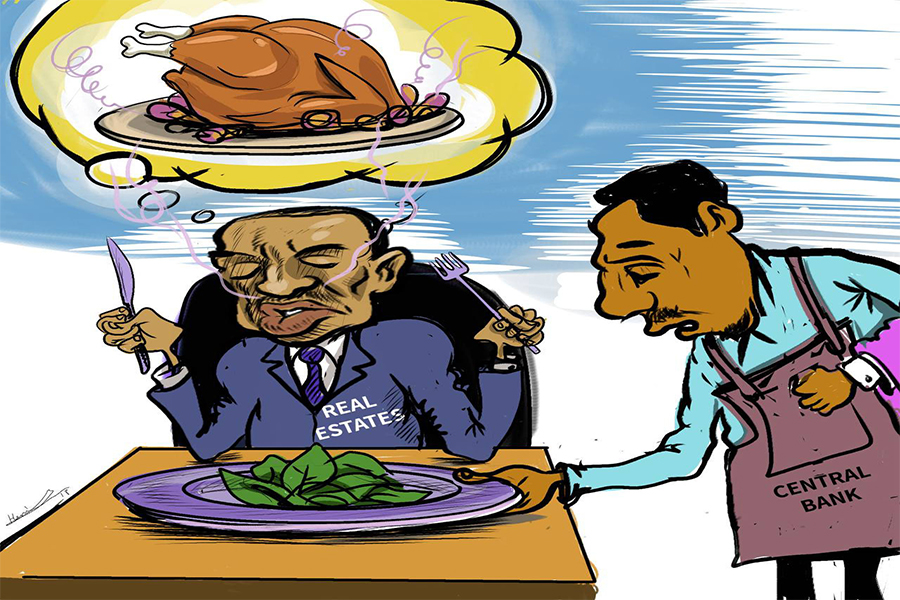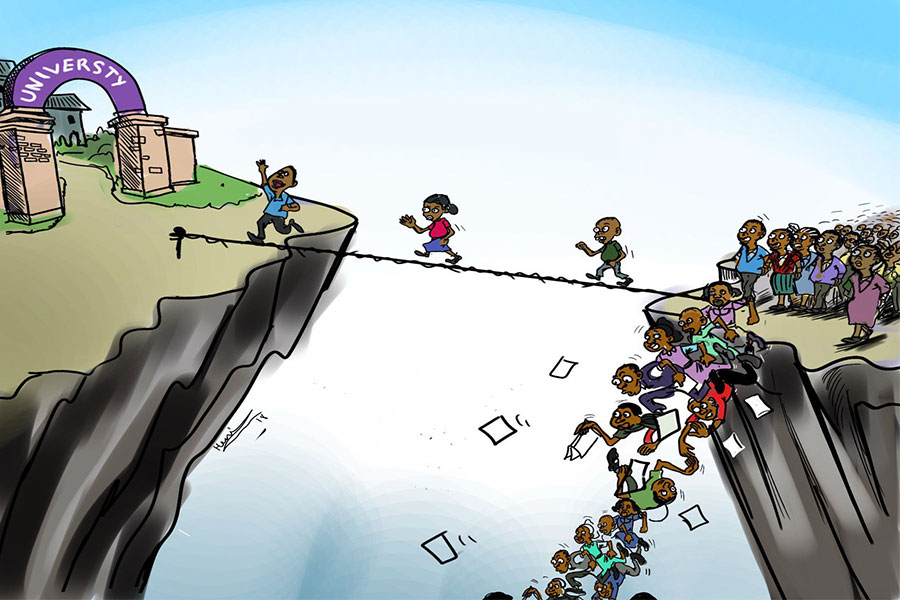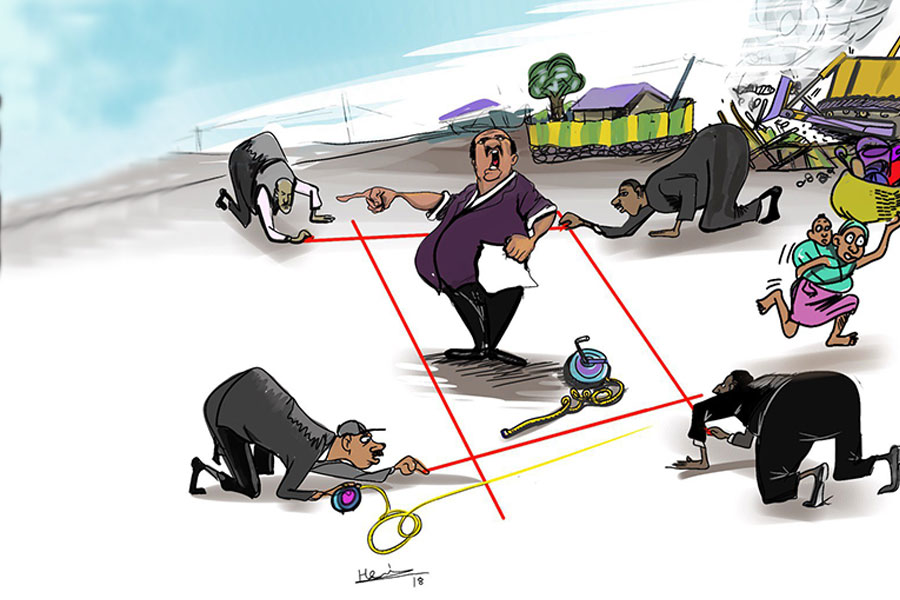
Photo Gallery | 173517 Views | May 06,2019
Sep 21 , 2025.
The Birr (Brewed Buck) spent the past week threading its way through a narrow but choppy stretch of the foreign-exchange market, giving banks a clear view of the pressures bubbling beneath the currency’s surface. Across six trading days, the weighted average rate remained at around 143.7 Br to the dollar (Green Buck), almost mirroring the National Bank of Ethiopia’s (NBE) official benchmark.
Stability in the headline number, however, masked wide splits at individual banks, where buying and selling quotes told a livelier tale about competition, liquidity and policy guessing games.
The state-owned Commercial Bank of Ethiopia (CBE), the market’s heavyweight, reclaimed the role of anchor. It bid for dollars at 138.7 Br and capped offers at 141.5 Br, a deliberate display of restraint that market watchers read as a signal for calm. Private lenders were less bashful. Oromia Bank, the perennial player, lifted its buying rate to 143.5 Br and sold greenbacks as high as 146.4 Br, signalling either a deep thirst for foreign currency or a bet that depreciation risks are underpriced.
The gap between the CBE and Oromia showed the tension between managed stability and the realities of scarce hard currency. Oromia Bank's aggressive posturing could reveal that private banks' willingness to test boundaries.
Amhara Bank pushed the envelope further. At one point, it posted a selling price of 147.9 Br while buying at 145 Br, levels that sat well above the market median and drew raised eyebrows in a market accustomed to tight Central Bank oversight. It could be a sign of mismatched liquidity and pent-up demand.
Even with such extremes, most banks inched quotes higher through the week, a quiet acknowledgement that the Brewed Buck remained under depreciation pressure. The average buying rate across all banks settled at 141.4 Br; and, the average selling rate, 144.3 Br. However, those means papered over a real range. Conservative players, such as Awash, Abyssinia, Wegagen and Zemen banks, kept bids close to 140 Br to 141 Br and barely budged. Among the big five private banks, Dashen ended the period with the highest bid at 142.48 Br.
Nib and Berhan, both smaller lenders, added noise to the tape. Nib Bank nudged its bid to 140.4 Br, while Berhan Bank spiked to 141 Br before retreating. Market watchers viewed their posturing as opportunistic rather than systemic.
Volatility rankings told another story, measured through daily percentage swings in buying rates. The five most jumpy banks were the Central Bank itself, Amhara, Ahadu, Enat and Nib banks. The Central Bank’s biggest one-day shift approached one percent, an eyebrow-raising move for a regulator that usually inches. Amhara and Ahadu banks clocked smaller but frequent jolts, likely tied to cash needs or peer realignment. Enat and Nib banks swung by up to half a percent. By contrast, Abyssinia, CBE, Dashen, Wegagen and Zemen banks barely moved, their volatility near zero.
Spreads, the gap between buying and selling quotes, sat at roughly two percent for nearly every bank except the NBE, uncovering the unwritten consensus. The Central Bank narrowed its margin from 0.04pc to zero by week’s end, erasing profit on official trades. Market watchers read the move as a sign that policymakers want to close arbitrage windows and keep maximum control of price discovery.
Behind the numbers lies a macro picture that remains tense. Inflation, a widening external financing gap and tight hard-currency supply keep gentle but persistent pressure on the Brewed Buck. Most private banks widened quotes gradually, maintaining stable spreads, signalled at competitive alignment rather than a slugfest. Outliers such as Amhara and Oromia banks, with their hefty premiums, likely reveal unique liquidity stress.
CBE’s disciplined pricing, meanwhile, felt almost choreographed. The state lender demonstrated fiscal orthodoxy, while private counterparts navigated with fewer guardrails. The message was clear that stability is the brand, yet flexibility remains in demand.
The leadership change at the central bank added to the unease. Prime Minister Abiy Ahmed (PhD) appointed Eyob Tekalegn (PhD), state minister for Finance, as governor, replacing Mamo Mihretu. Eyob brings a resume that stretches from diplomacy to a private-equity firm at SGI Frontier Capital, as well as board seats at Ethio telecom and Ethiopian Investment Holdings. His technocratic reputation now meets the currency maze.
During his first week, the headline average stayed flat, but the undercurrent stirred. When the Central Bank erased its spread on September 19 and again on September 20, market watchers saw an effort to choke off arbitrage and signal a stabilisation push. Narrowing the spread to zero prioritises symbolism over revenue. It tells the market that stability trumps profit, at least for now. Whether that posturing holds under sustained demand will be Eyob’s early test.
However, the Brewed Buck's gentle glide hides moments of intensity. Each time a private bank ratchets quotes upward, peers follow in smaller steps, sustaining the facade of order while inching toward a weaker currency. Those small escalations matter because Ethiopia is entering tough talks with external creditors. A sudden slip could dent confidence as officials need goodwill, presenting a dilemma to policymakers.
Analysts caution that tight control can steady expectations, but too much rigidity risks starving liquidity and back-door premiums. Last week's trend signalled an inflexion point where either the Central Bank reins in the sporadic jumps or uses them as safety valves on the road to a looser regime. Signs of strain emerged midweek when Hibret Bank bumped its bid from 139.97 Br to 140.501 Br and froze there, while Lion Bank crept from 141.75 Br to 141.96 Br. Such two-decimal precision revealed how closely treasurers watch peers and the daily fix.
The skew was clearest in the daily high and low, where the CBE and conservative peers anchored one end, Oromia and Amhara banks stretched the other. A currency that shifts less than one percent on paper may still show jagged edges at individual desks. For regulators, that asymmetry can serve as a warning and a tool, proof that official stability works but only with vigilance.
By Friday’s close, the numbers looked calm, with the weighted average stuck at 143.7 Br, the gap with the reference rate nearly invisible. Underneath, though, the Brewed Buck proved restless. State lenders preached steadiness, private banks probed edges, and policymakers adjusted tools in real time.
PUBLISHED ON
Sep 21,2025 [ VOL
26 , NO
1325]

Photo Gallery | 173517 Views | May 06,2019

Photo Gallery | 163737 Views | Apr 26,2019

Photo Gallery | 153739 Views | Oct 06,2021

My Opinion | 136529 Views | Aug 14,2021

Oct 11 , 2025
Ladislas Farago, a roving Associated Press (AP) correspondent, arrived in Ethiopia in...

Oct 4 , 2025
Eyob Tekalegn (PhD) had been in the Governor's chair for only weeks when, on Septembe...

Sep 27 , 2025
Four years into an experiment with “shock therapy” in education, the national moo...

Sep 20 , 2025
Getachew Reda's return to the national stage was always going to stir attention. Once...